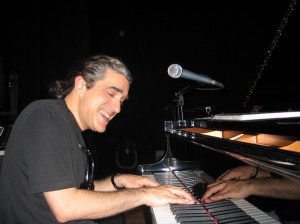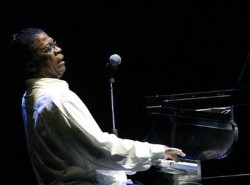Fahir Atakoglu Vs. Herbie Hancock
posted in: Features
 Jazz is one of the first true American forms of music. Developed by African Americans in the early twentieth century, jazz was one of the first genres to be developed entirely by Americans that was not influenced by European classical and romantic music. Jazz reached it’s height of popularity in the first half of the twentieth century; breaking into the mainstream in the 1920s and continuing it’s popularity through the 1940s and 1950s. Although jazz has spread around the world and continues to have a dedicated fan base, it’s popularity in the mainstream has waned in recent years. But here at OurStage we think all genres need some love, which is why our latest edition of Vs brings you Turkish-born pianist Fahir Atakoglu matched up against one of the most famous jazz pianists, Herbie Hancock.
Jazz is one of the first true American forms of music. Developed by African Americans in the early twentieth century, jazz was one of the first genres to be developed entirely by Americans that was not influenced by European classical and romantic music. Jazz reached it’s height of popularity in the first half of the twentieth century; breaking into the mainstream in the 1920s and continuing it’s popularity through the 1940s and 1950s. Although jazz has spread around the world and continues to have a dedicated fan base, it’s popularity in the mainstream has waned in recent years. But here at OurStage we think all genres need some love, which is why our latest edition of Vs brings you Turkish-born pianist Fahir Atakoglu matched up against one of the most famous jazz pianists, Herbie Hancock.

OurStage's Fahir Atakoglu

Herbie Hancock
Herbie Hancock is one of the most prolific and well-respected musicians in the history of jazz. With forty-eight studio albums to his name, he has covered ground in almost all the subgenres of jazz and beyond. From bebop, to jazz fusion, to funk and even R&B, Hancock has covered it all. Likewise, Fahir Atakoglu has a wide range of styles and influences permeating throughout his music. For example, “Mediterranean” fuses stylistic influences from both Spain and the Middle East in the same song. Beginning with an upright bass solo, the song features three other solos from clarinet, piano and acoustic guitar. These solos have an obvious influence in sound from traditional Spanish music. However, between each of these solos is a repeated melody that has a completely different style. The sound of this section is clearly influenced by Middle Eastern music, and that striking contrast is meant to grab the listener’s attention when it comes in.
On “Seven,” Fahir decides to get funky with this great jazz fusion track. You know you’re in for something cool when you hear a song start out with a ‘wah wah’ effect on the electric guitar, and “Seven” does not disappoint. Featuring two great trumpet solos and a piano solo, the highlight of the song is the face- melting electric guitar solo about halfway through the song. Yes, you read that correctly. Most jazz artists are not known for including face-melting guitar solos in their songs, but this just shows how versatile Atakoglu’s styles and arrangements are.
Speaking of versatile, after tearing through the high powered funk of “Seven,” Atakoglu can turn right back around with the soft and delicate ballad “Your Face.” Featuring an interplay of solos between tenor saxophone and piano, this ballad sounds like it could have come right out of the golden age of jazz. In fact, this song is very similar to a lot of the music Herbie Hancock recorded in the 1960s. If you listen to Hancock’s song “Alone & I”, off of his 1962 debut album Takin’ Off, you can hear the obvious similarities. The songs are both ballads that are nearly identical in tempo, and they both feature emotional solos on saxophone and piano. The Hancock tune also has an additional trumpet feature, still it’s quite possible that Atakoglu wrote “Your Face” as a homage to the jazz legend. Regardless, the job of a bandleader in jazz is to arrange compositions in a way that gets the best performance out of all the supporting musicians, and it is obvious from this track that Atakoglu is fantastic at doing just that. The song relies heavily on the improvisation of tenor saxophone player Bob Mintzer, and he gives a simply breathtaking performance. Fahir Atakoglu is proving to the world not only that jazz is not dead, but that it can continue to innovate and advance forward in the twenty-first century.
You can buy Fahir Atakoglu’s album Faces & Places from his Web site.
